Thursday 13th May 2021

No sooner had I posted yesterday morning’s blog about Aberdeen’s hydrogen buses came news TfL and its contractor Metroline had chalked up a ‘world second’ by introducing one of their similar fleet of Wrightbus built hydrogen double deck buses into service in London for the first time yesterday.
TfL have long experience operating hydrogen buses, having run a small fleet of single decks on former route RV1 as long ago as 2004.

As I was in London for other reasons yesterday, it was a good opportunity to track the bus down and take a ride to compare it with my experience in Aberdeen on Monday. I’m pleased to report the ride quality is good with some smooth driving at a sedate pace.
Metroline have had 20 of these hydrogen powered double decks in its fleet for some time. They’re owned by TfL and leased to Metroline. Entry into service on route 7 between East Acton and Oxford Circus has been waiting the final commissioning of fuelling facilities at the company’s Perivale base. Specialist staff from Denmark needed to finish the job and have been unable to travel during the height of the pandemic, hence the delay.

Financing for the infrastructure and buses has come from the same EU fund as for the trial in Aberdeen, and later this year, in the West Midlands too. It’s called JIVE (supposedly standing for Joint Initiative for hydrogen vehicles). This project is “deploying 139 new zero emission fuel cell buses and associated refuelling infrastructure costs across five countries. JIVE will run for six years from January 2017 and is co-funded by a 32 million euro grant from the FCH JU (Fuel Cells and Hydrogen Joint Undertaking) under the European Union Horizon 2020 framework programme for research and innovation”.
One of the objectives of JIVE is to “achieve a maximum price €625k-€650k for a standard fuel cell bus thanks to economies of scale – or lower”. These TfL buses have cost £543,000 each but after the grants from JIVE have a net cost to TfL of £238,000. There’s a reply to a Freedom of Information request about these buses with some more information on TfL’s website here.
The buses were ordered two years ago in May 2019 and it had originally been hoped to introduce them during 2020.
The overall project including buses and fuelling infrastructure has cost £12 million with half of that coming from grants, and TfL paying the rest.

Aside from the rather odd yellow warning notices placed around the bus – this bus had three – I also spotted one on a bus in Aberdeen which I was led to believe was left from when the buses were first delivered and is now removed – passengers would be hard pressed to know they were travelling on anything other than a standard red-all-over liveried ‘green propulsion friendly’ fleet around London. The buses sport the usual decor and seat types and the quieter engine noise befitting other electric and greener propulsion vehicles.
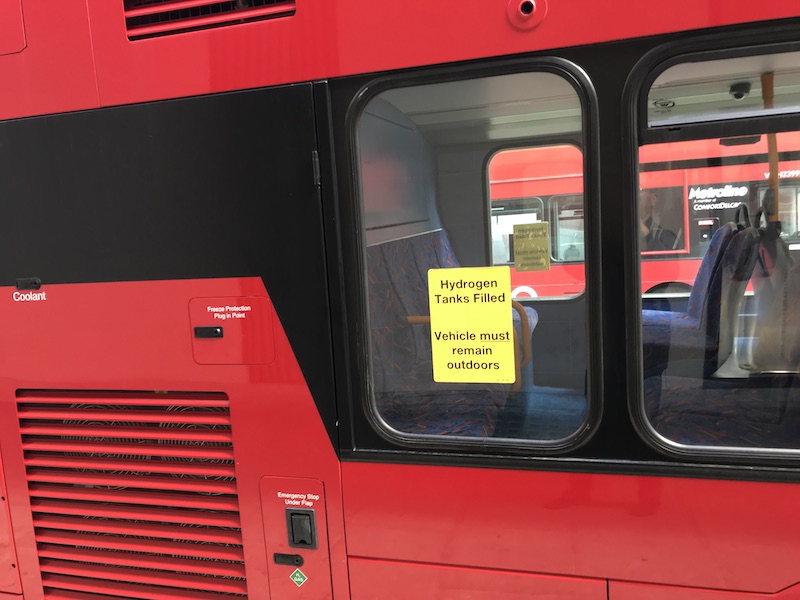
This bus doesn’t even sport the green leaf type foliage vinyls some of the electric and hybrid buses wear in London telling you they’re green buses.

Anyway, never mind the hydrogen and all that cost. What about the seating? I know I’m becoming fixated about it following my Aberdeen trip, but I also know from feedback to yesterday’s blog I’m not the only one concerned about this.

Once again, those with accessibility issues will certainly notice the lack of no-step seating on the lower deck. As in Aberdeen there are just two double seats available making for four seats in total. London’s specification of a centre exit means the lower deck layout is even more of a muddle than in Aberdeen.
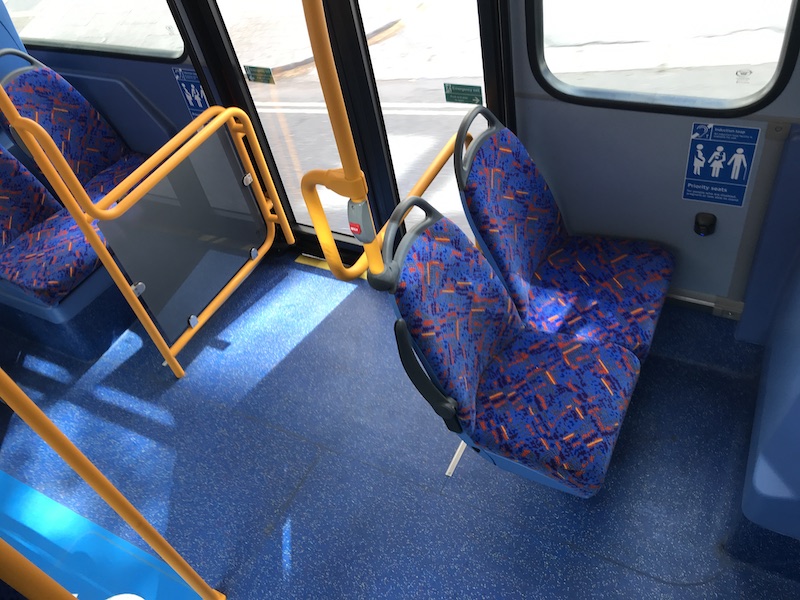
There’s a double seat on the nearside behind a smaller luggage rack (than in Aberdeen) and in front of the centre doors.
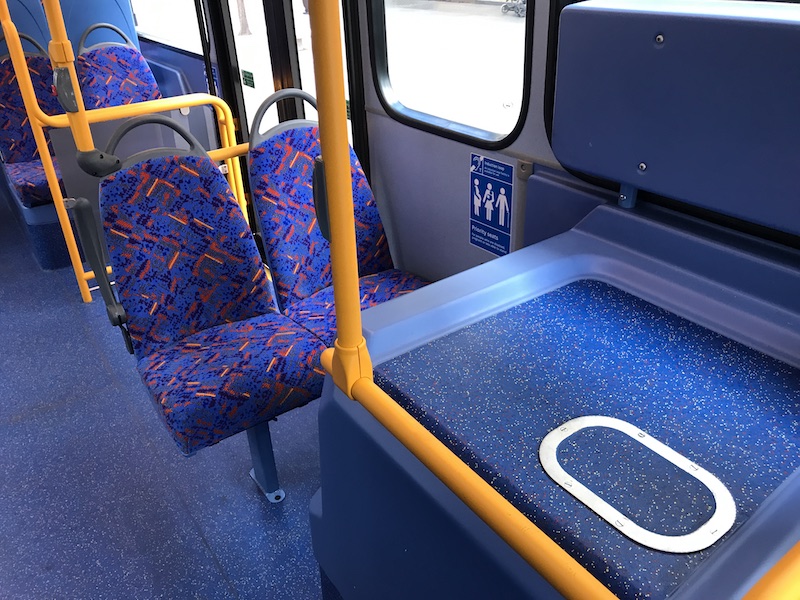
TfL don’t allow tip up seats on their contractors’ buses so those five seats seen in Aberdeen are gone and the wheelchair space in London is on the offside.

The second double seat with no step is immediately behind the centre doors.

Seats further back over the rear wheels include a pair facing each other on the nearside…

… while on the offside there’s two forward facing double seats and an oddly placed double bar contraption thing in which you could stow a briefcase if needed. Or more likely put your feet on.

At the rear the old tradition of squeezing in five seats is back at the back …

… with a double seat facing them on both sides.

On the upper deck there’s just four seats along the back …
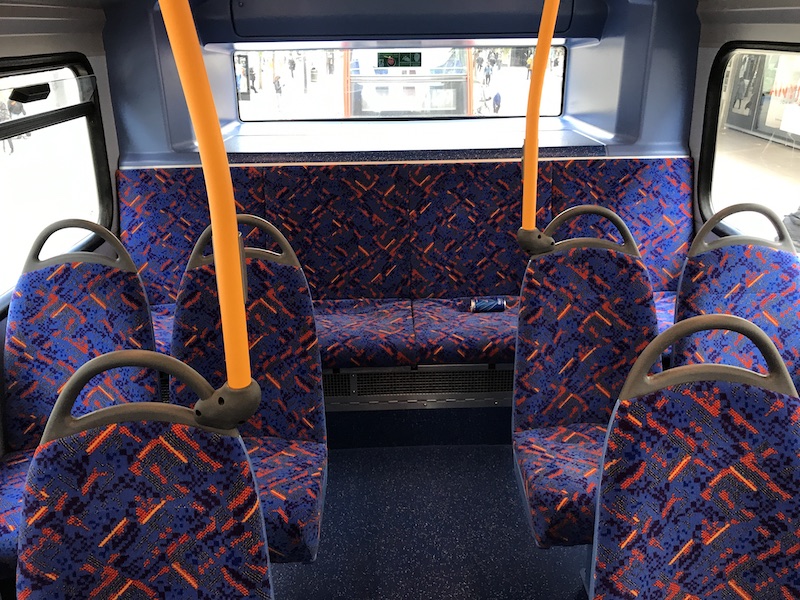
… and otherwise it’s pretty much a standard layout including generous spacing between the seats. Personally I prefer these seats and the moquette to the e-leather in Aberdeen.
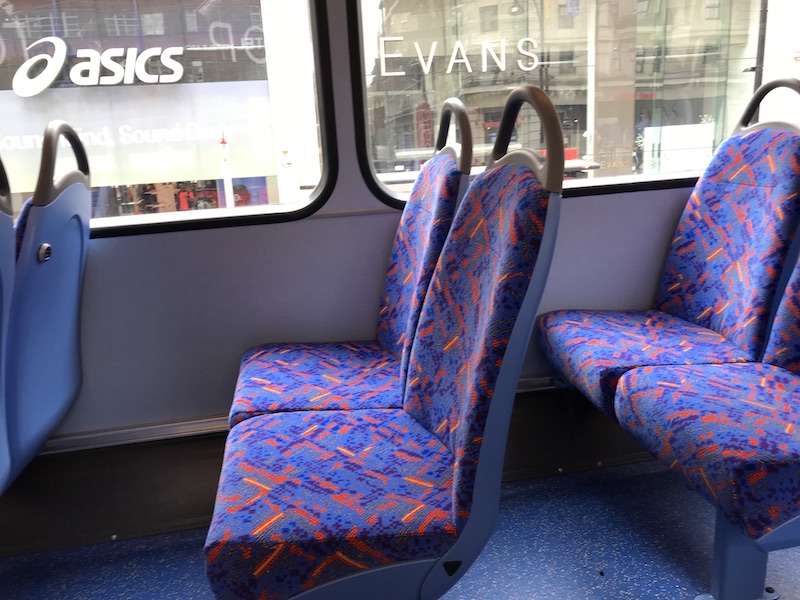
Other positives to note include usb sockets which are now standard on all new buses for TfL routes, which is good to see at last …

… and the straight staircase taking up less room.

The driver I spoke to was very pleased with the cab …


…. including the camera mirrors ….

… although he wasn’t so happy about the buses being restricted to a maximum speed of 20mph.

Another welcome development on TfL spec buses is a much improved destination blind display using a new high res LED Mobitech display developed by McKenna Brothers.

They look very good, and I’m sure even more so at night.
It’s good to see London catching up with many long standing initiatives from the provinces. I look forward to trying out many more ‘world seconds’ in the future.

Roger French


I can understand the driver’s feelings about the bus being restricted to a dawdling 20mph.
Why is this? Will it apply to all Hydrogen powered buses, or is it a new TfL ruling ?
LikeLike
TfL would like a blanket 20mph limit across inner London. At present it can only do this on roads it controls. I suspect therefore that the bus limiter is to aid compliance with this. But presumably there will be times when they stray beyond these roads? See: https://tfl.gov.uk/corporate/safety-and-security/road-safety/safe-speeds. BTW Cardiff, where I live, is increasingly rolling out 20mph limits.
LikeLike
London boroughs are also introducing 20mph limits: this map of Haringey shows that all roads will be/are 20mph except those marked (some of which presumably are bus routes .,..): https://www.haringey.gov.uk/sites/haringeygovuk/files/roads_excluded_from_20mph.pdf
LikeLike
If they limited them to 20mph they are going to push costs up. Probably in Central London they never do much more than 20mph other than at night but in Outer London on many routes it would have a major impact on timetables and would reduce the number of journeys a bus could do. Slowing journeys down is another disincentive to use buses as well
LikeLike
So on a road where the speed limit is 30 mph, and the traffic is free-flowing, these buses can only travel at 20 mph, causing traffic to pile up behind, or worse, encourage drivers to overtake, sometimes potentially dangerously? And all for what? A man running with a red flag in front could be faster!
You mentioned that the Aberdeen buses had very restricted leg room at the front offside seats upstairs. Is that also the case with the Metroline buses?
LikeLike
The restricted leg/foot room in Aberdeen was on the former Volvo double decks used on the route. Pleased to report it’s better on the new buses, as it is on Metroline’s. Good to see that.
LikeLike
I can’t understand why TfL downplay the green credientials of their *very* expensive new buses. The 20 is run by CT Plus with hybrid Enviro400 Citys complete with the small green leaf motif. But recently one of the 2 new all electrics was on the route; I only noticed through the fleet number and different wording with the small green leaf motif. Why don’t TfL shout about these very expesive new electric buses on the side of them like the early hybrids’ leaf livery?? I’m sure Ray Stenning & Best Impressions could come up with something classy yet corporate!
LikeLiked by 1 person
Yes, even something like a metallic lightning bolt down the sides and big, shouty “A NEW ZERO-EMISSIONS HYDROGEN BUS FOR LONDON” posters would do the job nicely.
LikeLike
They do now have associated branding applied to promote them as being Hydrogen Vehicles.
They have the Green Leaves, “Hydrogen Clean Air for London” branding, “I’m a Hydrogen Bus” branding and a nice mid deck orange band.
LikeLike
I don’t think I’d like to link hydrogen with thunderbolts …
LikeLike
I guess the effect of the 20mph maximum will be noticed more on the dead garage runs between East Acton and Perivale along the A40
LikeLike
I went on the second bus in service yesterday from Paddington to Oxford Circus, very smooth and quiet with no rattles from the bodywork. I was sitting upstairs at the back and it felt as though we were going faster than 20mph along a fairly clear Edgware Road. There was just one poster on the cove panel right at the back telling passengers (just a few, they clearly don’t want to shout about it) that is is a hydrogen fuel cell bus.
LikeLiked by 1 person
Well if a bus is only doing 20 mph I would expect a fairly smooth and rattle free ride
LikeLike
I presume you don’t travel on Streetdecks Bob. They’re awful at slow speeds
LikeLike